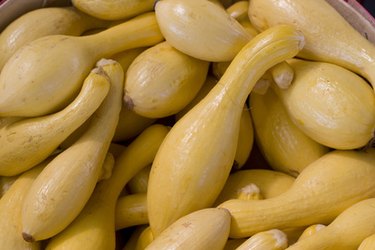Things You'll Need
4 or 5 gallon plant container and tray
Utility knife
Fiberglass screen
Potting soil
Squash seeds
Watering can
Scissors
Water-soluble, slow-release fertilizer

It's not necessary to have a large garden, or even a small one, to grow your own fresh vegetables. The bush type varieties of squash are ideal for growing indoors in containers. They require less room to grow than the sprawling vine varieties of squash planted in the garden and give you the same amount of squash to harvest as those grown in a garden outdoors. Plant the seeds in a container in early July and have fresh squash ready to harvest in 50 to 60 days.
Step 1
Cut a piece of fiberglass screen to place in the bottom of the plant container. It should be large enough to cover the drainage holes to keep the potting soil in and plant pests out.
Video of the Day
Step 2
Fill the plant container with potting soil until it's about 1 inch from the top of the pot.
Step 3
Place five to six squash seeds in the middle of the container and cover them with a 1/2 inch of potting soil.
Step 4
Water the soil until water runs out of the drainage holes in the pot. Place the container in an area that will receive sunlight for six to eight hours per day. Place plant containers in an area protected from the wind if you set them outside.
Step 5
Cut off the smallest squash seedlings with scissors at the soil line five to 10 days after planting, when seeds germinate. Leave the two largest seedlings in the plant container.
Step 6
Cut off the smaller of the two squash plants at the soil line when they are 8 to 10 inches tall.
Step 7
Fertilize the squash when the plant is about two weeks old, then once a week until it's time to harvest. Follow the directions on the label for amount of fertilizer to add.
Step 8
Water squash plants when the top inch of soil feels dry. Check the plants at the same time for signs of disease or pests.
Tip
If you want to mix your own potting soil, combine equal parts of sphagnum peat moss, perlite and compost. Dampen the peat moss before mixing to allow it to combine easier with the perlite and compost.
Warning
Do not use garden soil for container grown vegetables. Do not fertilize squash plants when the soil in the container is dry.
Video of the Day
- Ohio State University Extension: Growing Cucumbers, Peppers, Squash and Tomatoes in Containers
- Arizona Cooperative Extension: Vegetable Garden-Container Garden
- Cornell University: Summer Squash
- AgriLife Extension: Vegetable Gardening In Containers
- University of Florida IFAS Extension: Minigardening(Growing Vegetables in Containers)